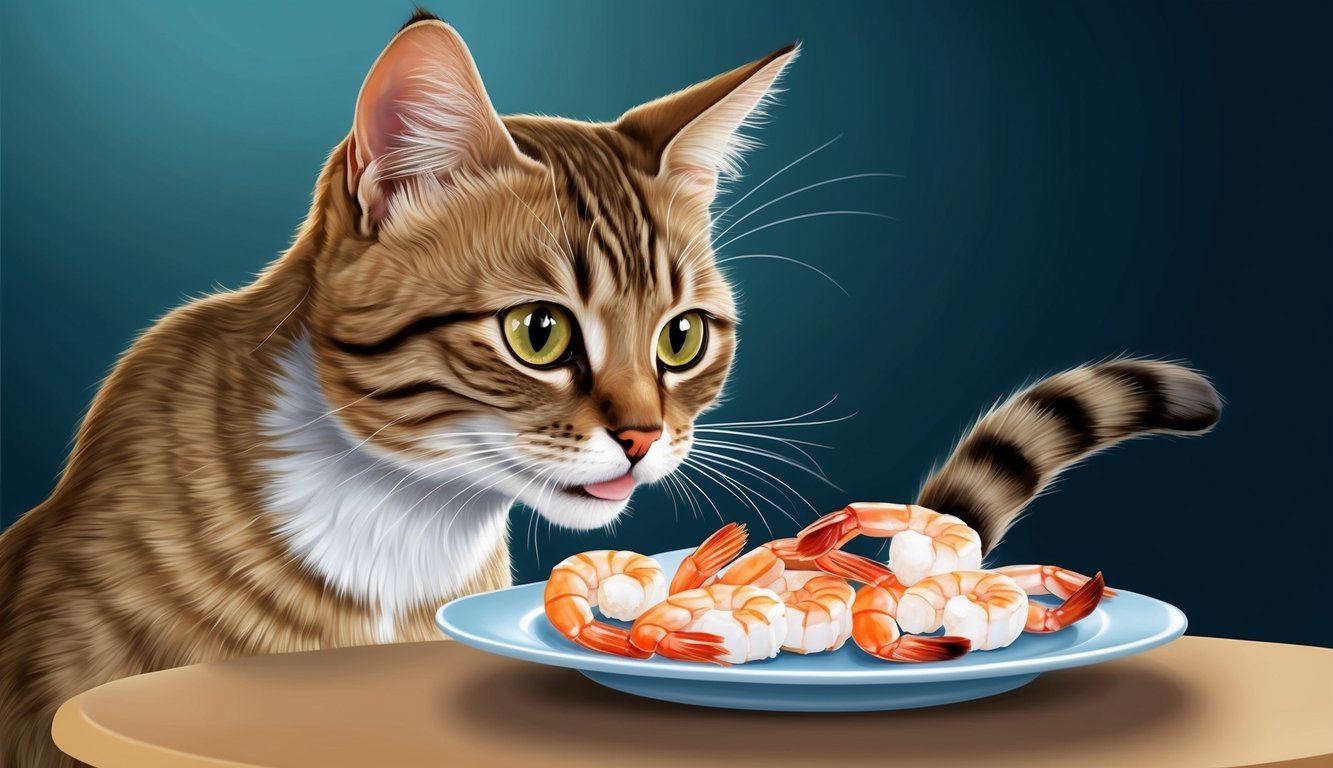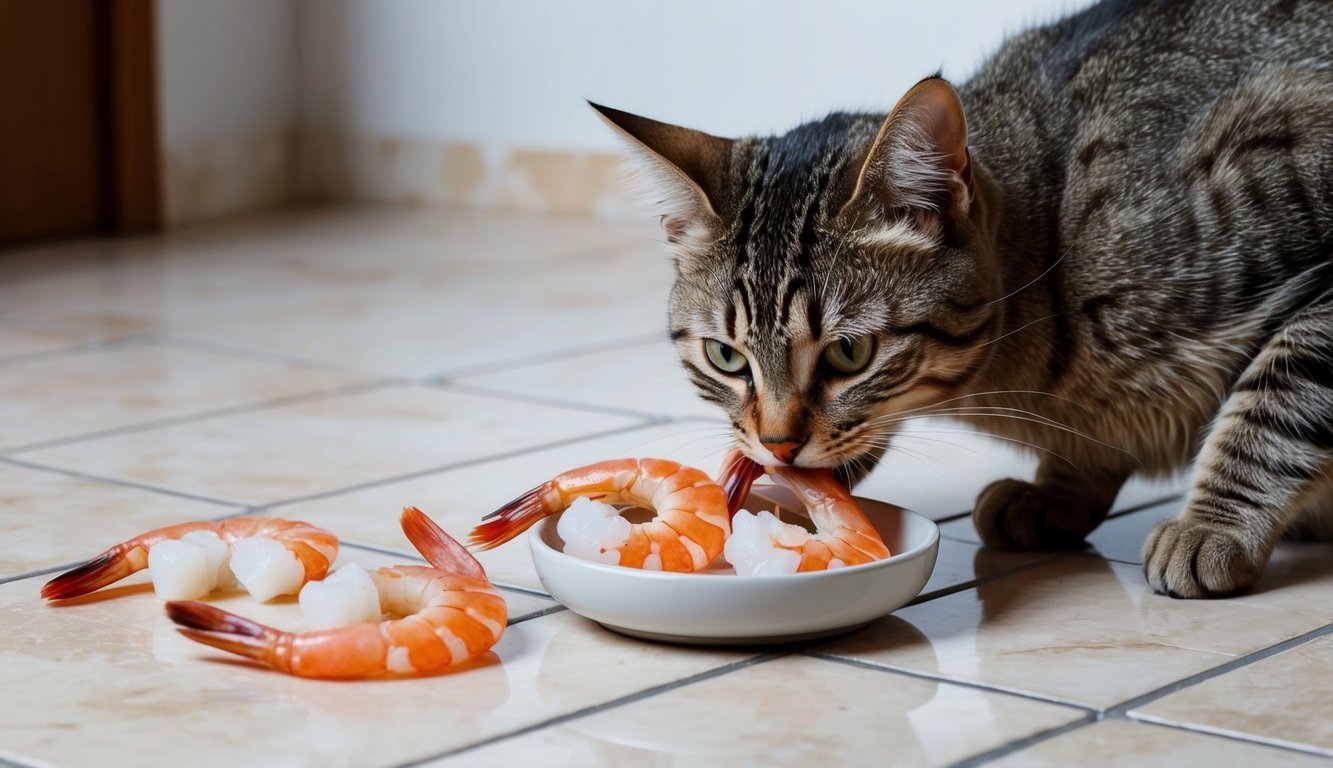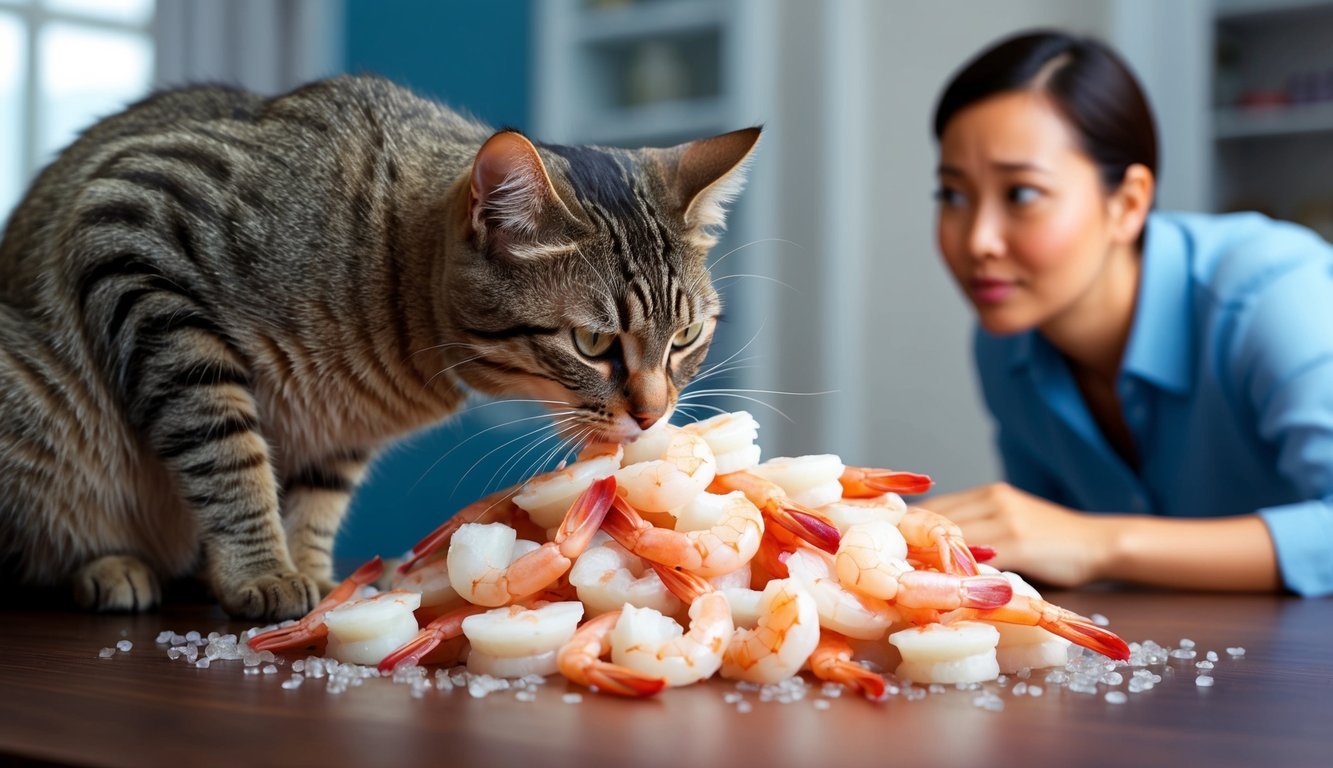Many cat owners wonder about the safety of feeding their furry friends different kinds of food, and shrimp is often a topic of interest. Cats can enjoy shrimp as a treat, but you should avoid serving raw shrimp due to potential health risks. Cooking shrimp renders it safer by eliminating harmful bacteria that could make your cat ill.
If you’re considering adding shrimp to your cat’s diet, there are benefits to cooked shrimp, as it can be a good source of protein and other nutrients.
However, moderation is key.
Knowing how much to feed and how often can help you avoid any adverse reactions or allergies that might arise from introducing new foods to your cat’s menu.
In this article, you’ll discover the facts you need to make informed decisions about whether shrimp can be a part of your cat’s diet and how to serve it safely.
Key Takeaways
- Cooked shrimp can be a healthy treat for your cat in moderation.
- Raw shrimp poses health risks and should be avoided.
- Always pay attention to serving sizes to prevent overfeeding.
Benefits of Shrimp for Cats
Shrimp can be a delightful treat for your cat when prepared correctly.
They offer nutrition that can support your feline friend’s health, particularly due to their low calorie count and high protein content.
Let’s explore these benefits in more detail.
Low Calorie Treat
Shrimp are relatively low in calories, making them a great option for cats that need to maintain or lose weight.
For example, a three-ounce serving of shrimp contains approximately 84 calories.
This low calorie count allows you to offer shrimp as an occasional snack without contributing excessively to your cat’s daily caloric intake.
In moderation, it can satisfy your cat’s cravings without the risk of weight gain.
Just remember to keep portion sizes small to keep treats balanced with their main diet.
Protein Content and Obligate Carnivores
As obligate carnivores, cats require a diet rich in protein for optimal health.
Shrimp are an excellent source of protein, containing about 19 grams per three-ounce serving.
This protein supports muscle development and maintenance.
Including shrimp in your cat’s diet provides essential amino acids crucial for overall health.
Offering shrimp occasionally can enhance the nutritional variety in their meal plan while satisfying their instinctual dietary needs.
Just ensure that it is cooked, with no added seasonings, to make it a safe and enjoyable treat for your kitty.
Feeding Raw Shrimp to Cats
Feeding shrimp to your cat might seem like a tasty treat, but there are several important factors to consider, especially when it comes to raw shrimp.
Understanding the safety risks and how to prepare shrimp properly can help you keep your feline friend healthy.
Safety Considerations
Raw shrimp can pose significant risks to your cat.
It may carry harmful bacteria and parasites, such as Vibrio spp., which can lead to serious digestive issues and illness.
Avoid offering raw shrimp altogether to prevent these health problems.
If you choose to treat your cat to shrimp, opt for cooked shrimp instead.
Cooking it thoroughly kills bacteria and parasites, making it much safer.
Always consult your veterinarian before introducing new foods, especially if your cat has existing health issues.
Preparing Raw Shrimp
While preparing raw shrimp for pets is not recommended, if you accidentally find yourself with shrimp intended for cooking, remember to handle it properly.
First, always wash your hands before preparing seafood to avoid cross-contamination.
If you’re cooking for your cat, steam or boil the shrimp without any seasonings.
Seasonings can be harmful to cats, so keep it plain.
Here’s a quick reference for cooking shrimp:
| Cooking Method | Notes |
|---|---|
| Boiling | Cook thoroughly in water. |
| Steaming | Keep it moist but not soggy. |
| Grilling | Avoid charred bits; keep plain. |
Keep shrimp portions small.
For an average-sized cat, 1-2 small pieces a few times a week is plenty.
Cooked Shrimp as a Feline Treat

Cooking shrimp for your cat can be a great way to provide a tasty and nutritious snack.
By preparing it properly, you can ensure it is safe and healthy for your feline friend.
Here’s how to do it and why cooked shrimp is a better option than raw.
How to Cook Shrimp for Cats
When cooking shrimp for your cat, it’s essential to keep things simple.
Start by selecting fresh shrimp and avoid those with added seasonings or preservatives.
Here’s a quick guide:
- Boil or Steam: Boiling or steaming shrimp ensures it is cooked thoroughly without adding any oils or spices.
- Remove the Shell: Always remove the shell and tail before serving, as these can pose a choking hazard or cause digestive issues.
- Cool Before Serving: Let the shrimp cool to room temperature. This prevents burns and maintains a pleasant texture for your cat.
- Portion Control: Offer small pieces. For a standard-sized cat, 1-2 small cooked pieces a few times a week is ideal.
By following these steps, you can make sure that your cat enjoys a safe treat.
Benefits Over Raw Shrimp
Cooked shrimp offers several advantages compared to raw.
Firstly, cooking eliminates harmful bacteria and parasites that can be present in raw shrimp, keeping your feline friend safe from illness.
Secondly, shrimp is a good source of various nutrients, making it a healthy treat.
Some nutritional benefits include:
- Protein: Essential for muscle and tissue health.
- Vitamins: Rich in Vitamin B12 and other important nutrients.
- Minerals: Provides phosphorus and selenium for a healthy diet.
By choosing cooked shrimp as an occasional treat, you not only ensure safety but also add beneficial nutrients to your cat’s diet.
Just remember to keep portions moderate to prevent any digestive issues.
Serving Size and Frequency

When treating your cat to shrimp, it’s essential to keep portions small and infrequent.
This ensures they enjoy the treat without any health risks associated with overconsumption.
Here’s how to safely incorporate shrimp into your cat’s diet.
Shrimp as an Occasional Treat
Serving shrimp should not be a daily practice.
Limit the frequency to 2-3 times a week.
If your cat is of average size, you can offer 1-2 small cooked pieces at a time.
Larger cats can have 2-3 medium shrimp, while petite cats should only get half of a small shrimp.
Here’s a quick reference for serving size:
| Cat Size | Serving Size | Frequency |
|---|---|---|
| Average | 1-2 small pieces | 2-3 times a week |
| Large | 2-3 medium shrimp | 2-3 times a week |
| Petite | 1/2 small shrimp | 2-3 times a week |
Always monitor how your cat reacts to shrimp and adjust the serving size accordingly.
If they show any adverse reactions, discontinue feeding shrimp.
Potential Risks and Allergies

Feeding your cat shrimp can pose certain risks and highlight potential allergic reactions.
It’s essential to be aware of these factors to ensure your pet’s health and safety.
Allergic Reactions to Shrimp
Just like humans, cats can develop allergies to specific foods, including shrimp.
Symptoms of an allergic reaction in cats may include:
- Itching or scratching
- Gastrointestinal upset (vomiting or diarrhea)
- Swelling (particularly around the face)
If your cat has never eaten shrimp before, introduce it slowly.
Start with a small piece and monitor any reactions.
If your cat shows signs of an allergy, it’s best to avoid shrimp altogether.
Consult your veterinarian for tailored advice based on your cat’s health history.
Overfeeding Concerns
While shrimp is a tasty treat, moderation is key.
Overfeeding shrimp can lead to several health issues.
Cats require a balanced diet to maintain their health, and excessive shrimp can upset this balance.
Important points to consider:
- Limit shrimp to 2-3 small pieces, a few times a week.
- Avoid exceeding 3-4 ounces of cooked shrimp in a week.
- Too much shrimp can lead to an unbalanced diet and potential digestive issues.
Keeping portions reasonable helps maintain your cat’s overall health and prevents complications.
Anatomy of Shrimp: What’s Safe?

When considering shrimp for your cat, it’s essential to evaluate what parts of the shrimp are safe to eat.
Not all shrimp anatomy is suitable for feline consumption, and understanding the specifics can help ensure your cat stays healthy.
Shrimp Shells and Tails
Shrimp shells are the hard outer coverings that protect the meat inside.
While they are not toxic, they can pose a choking hazard for cats, especially if they are not chewed properly.
Small cats might struggle to handle larger pieces.
The tails of shrimp are also best avoided.
They can be sharp and hard, potentially causing injury to your cat’s digestive tract.
If you choose to offer shrimp, ensure it is peeled and the tails are removed.
Opt for cooked shrimp that is steamed or boiled without any seasoning to keep it safe for your feline friend.
Always monitor your cat when trying new foods to detect any adverse reactions.
Frequently Asked Questions
When considering whether to share shrimp with your cat, it’s important to address common concerns about safety, health benefits, and proper preparation.
Below are specific questions you might have regarding feeding shrimp to your feline friend.
Is it safe to give my cat raw shrimp?
Feeding raw shrimp to cats can pose risks.
Raw shrimp may harbor bacteria and parasites that can lead to gastrointestinal issues.
It’s generally safer to offer cooked shrimp, which eliminates these potential hazards.
Can feeding my cat cooked shrimp be a healthy treat?
Yes, cooked shrimp can be a nutritious treat for your cat.
It is rich in protein, vitamins, and minerals.
Just ensure that it is prepared without any seasoning or harmful additives.
How often is it okay for a cat to eat shrimp?
Shrimp should be offered in moderation.
For an average-sized cat, serving 1-2 small cooked pieces 2-3 times per week is appropriate.
Larger cats can have a few more pieces, while tiny cats should have smaller portions.
Are there any parts of shrimp cats should avoid, like the shell or head?
Yes, it’s best to avoid giving your cat shrimp shells and heads.
These parts can be hard to digest and may present choking hazards.
Stick to the meat of the shrimp for feeding.
Could cats have any adverse reactions to shrimp?
Some cats may have allergies to seafood, including shrimp.
Watch for symptoms like vomiting, diarrhea, or excessive itching.
If you notice any adverse reactions, discontinue feeding shrimp and consult your veterinarian.
Is there a specific way to prepare shrimp that’s best for cats?
The best way to prepare shrimp for your cat is to boil or steam it without any seasoning.
This method ensures that the shrimp remains safe and healthy for your feline.
Avoid fried shrimp or those cooked with oils or spices.


